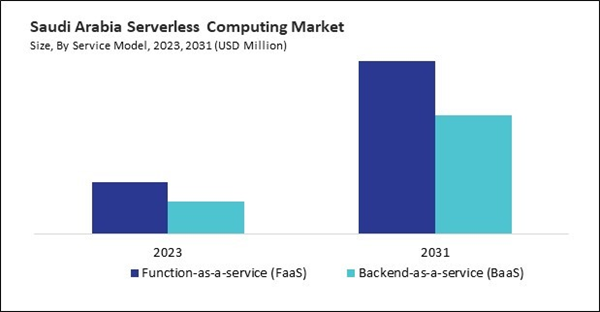The Brazil market dominated the LAMEA Serverless Computing Market by country in 2023, and is expected to continue to be a dominant market till 2031; thereby, achieving a market value of $1.29 billion by 2031. The Argentina market is showcasing a CAGR of 16.6% during 2024-2031. Additionally, the UAE market would register a CAGR of 14.7% during 2024-2031.
Another key driver of the serverless computing market is its inherent cost efficiency. Unlike traditional server-based models, where resources are often underutilized during off-peak periods, serverless architectures operate on a pay-as-you-go model. Businesses are billed only for the compute resources consumed during the execution of functions, with no charges for idle time.
Moreover, this pricing structure significantly reduces operational costs, making serverless computing particularly attractive for startups, small and medium-sized enterprises (SMEs), and organizations with variable workloads. By eliminating the need for upfront investments in infrastructure, serverless computing lowers the barrier to entry for businesses looking to leverage cloud-based solutions.
In Brazil, the e-commerce sector is undergoing significant expansion, driven by the growing accessibility of the internet and the emergence of a burgeoning middle class. According to the ITA, the sector is expected to surpass $200 billion by 2026, growing at an annual rate of 14.3%. Serverless computing solutions are becoming essential for e-commerce platforms to handle massive spikes in traffic during major sales events like Black Friday. These solutions ensure platforms remain functional and responsive during peak demand, enhancing customer satisfaction and driving sales in one of Latin America's largest e-commerce sectors.
List of Key Companies Profiled
- Amazon Web Services, Inc. (Amazon.com, Inc.)
- Microsoft Corporation
- Google LLC (Alphabet Inc.)
- IBM Corporation
- Oracle Corporation
- Alibaba Cloud (Alibaba Group Holding Limited)
- Cloudflare, Inc.
- Tencent Holdings Ltd.
- SAP SE
- Salesforce, Inc.
Market Report Segmentation
By Service Model- Function-as-a-service (FaaS)
- Backend-as-a-service (BaaS)
- Large Enterprises
- Small & Medium-sized Enterprises
- Public Cloud
- Hybrid Cloud
- Private Cloud
- BFSI
- IT & Telecom
- Healthcare & Life Sciences
- Retail & Consumer Goods
- Manufacturing
- Government & Defense
- Transportation & Logistics
- Other Industry Vertical
- Brazil
- Argentina
- UAE
- Saudi Arabia
- South Africa
- Nigeria
- Rest of LAMEA
Table of Contents
Companies Mentioned
- Amazon Web Services, Inc. (Amazon.com, Inc.)
- Microsoft Corporation
- Google LLC (Alphabet Inc.)
- IBM Corporation
- Oracle Corporation
- Alibaba Cloud (Alibaba Group Holding Limited)
- Cloudflare, Inc.
- Tencent Holdings Ltd.
- SAP SE
- Salesforce, Inc.
Methodology

LOADING...









